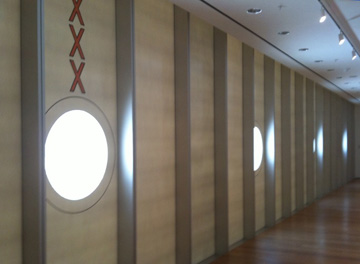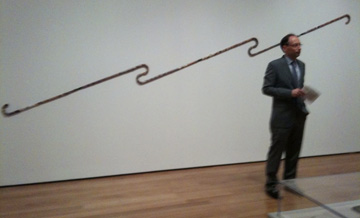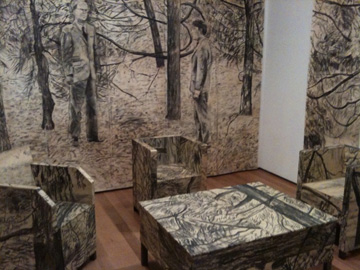
Jan Dibbets. "Untitled" (1969). Photolithographed postcard, 4 1/16 x 6” (10.3 x 15.2 cm). Publisher: Seth Siegelaub, New York. MoMA. Art & Project/Depot VBVR Gift. © 2009 Jan Dibbets/Artists Rights Society (ARS), NY. MoMA Imaging Studio, photograph: Jonathan Muzikar
While today Conceptual Art is utterly ubiquitous, MoMA’s current “In & Out of Amsterdam: Travels in Conceptual Art, 1960-1976” examines a period when only a few cities in the world seemed to embrace this idea-based world of visual art, foremost among them, Amsterdam.
In this well-curated show of objects–which is somewhat ironic since conceptual art often rejected the very notion of the art object–MoMA’s curator of prints and illustrated books Chirstophe Cherix focuses on an influential gallery in Amsterdam, Art & Project, that served as a laboratory for conceptual art practice when it opened in 1968.
Spurred by a recent gift of 230 works by the founders of Art & Project (Geert van Beijeren and Adriaan van Ravesteijn) to the MoMA, this show fills in the blanks of our art historical knowledge, most notably the connection between Los Angeles and Amsterdam. Phillip Van den Bossche describes the unique connection between these two cities in the catalogue as “the first direct links between Europe and the American West Coast–which is to say without New York playing an intermediary role.”
The exhibition offer a great deal of insight into the work of a number of Art21 artists who were either in contact with some of these seminal figures or more significantly benefited and learned from this generation of conceptual artists, including Jenny Holzer, Barbara Kruger, Allan McCollum, and Bruce Nauman, all of whom experiment with objects, language and narrative.

Lawrence Weiner's redesign of the hallway that leads to the "In & Out" exhibition
At the entrance to the exhibit there is a commissioned piece by Lawrence Weiner that combines nautical forms and triple-X wall images, both alluding to the city’s role as a major port for shipping and site for pleasure. On the right side of the hall, an eclectic collection of Dutch posters from the period set the mood.
Inside the artists on display are diverse, from the enigmatic Stanley Brouwn to the vibrant work of Gilbert & George, and they tell the story of this city, which was at the time an incredibly progressive and open place that welcomed new ideas around the world.
Amsterdam’s role in the story of Conceptual Art is not limited to its role as a hub for European artists but as an important entry point for many Americans during their adventures across the Atlantic. Of the 10 artists on display, three are American (Sol LeWitt, Allen Ruppersberg & Lawrence Weiner) and two are Dutch artists trained in Los Angeles (Ger van Elk & Bas Jan Ader).

Curator Chirstophe Cherix during the press preview of the exhibition in front of Ger Van Elk's "Los Angeles Freeway Flyer" (1973), Coll. Rijksmuseum Twenthe
The show was dominated by small–sometimes serialized–objects safely behind plexiglas or hanging on the wall but there are some room-sized installations which evoke the power of a movement that sought to shift our understanding of the art object.
Gilbert & George’s The Tuileries (1974) is arranged in an alcove and comprised of furniture and wallpaper covered with drawings of the artists in a well-known gay cruising spot in Paris. The collision of private lives and public display are provocative for an era where the boundaries between art and life were fast disintegrating. Likewise, Charlotte Posenenske’s large Series D (1967) is composed of manufactured ducts made of hot galvanized sheet steel. They straddle the line between aesthetic minimalism and industrial utility. Aesthetics, the work seem to suggest, are contextual.

- Gilbert & George, “The Tuileries” (1974), Coll. Rijksmuseum Twenthe
Some works, like Ger van Elk’s Paul Klee-Um Den Fisch, 1926 (Around the Fish) (1970), play with art historical references. The work, comprised of a slide projector and a draped box, satirizes an iconic work by Paul Klee of a fish on a plate by recreating the scene in real life and then proceeding to eat the fish. What surprised me most about “In & Out in Amsterdam” is that while at the time most of the art in that historic period would have seemed irreverent, today it looks surprisingly classical.
The artists included in “In & Out of Amsterdam” are: Bas Jan Ader, Stanley Brouwn, Hanne Darboven, Jan Dibbets, Ger van Elk, Sol LeWitt, Charlotte Posenenske, Allen Ruppersberg, Lawrence Weiner, and Gilbert & George. The exhibition continues until November 9, 2009 and it is in conjunction with “In & Out of Amsterdam: Art & Project Bulletin, 1968–1989” in MoMA’s Paul J. Sachs Prints and Illustrated Books Galleries.



